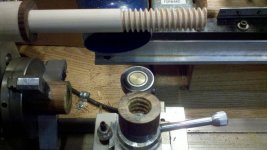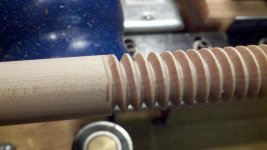Has anyone tried the Beal Tool Company threading kits for threading cue parts?
http://www.bealltool.com/products/threading/threader.php
Dave
http://www.bealltool.com/products/threading/threader.php
Dave
I asked this question, knowing that there will be either a smart a$$ response, or just a shunning of the tool. I actually have a set of 2 sizes and have been playing with it for a couple days. I am amazed at how simple it works, and the quality of the threads it makes. I have spent $100 on stupid compression threaders that some of you sell, that work like Sh!%, and this only cost $65 more.
I asked an honest question, and received some very good pm's and I thank those people for that.
For the rest of the posters.....
Most of the posts were childish to say the least!
So if one needed to thread a 29" core dowel, how would one, or NASA, do it? When they don't have the funding for $$$$ equipment?
It's easy for someone that is considered a 'big dog' in cue building to scoff at tools like this, but what do you offer as an alternative?????? In the same price range would be nice.
As to building chair legs, well if it can hold a fat a$$ (like some on here have...) on the chair, then I guess using the same methods will build a cue that will hold up very well for a long time.
A bit of info also, the threads per inch is only dictated by the delrin insert that is pre threaded. The depth of thread is adjusted by the router bit height. If you build your own insert and thread it with a, say, 5/8x11, then would it be 'acceptable' for cuebuilding? I'm a bottom dweller and even I figured that out. Maybe some of you 'BIG DOGS' should actually look at the tool before commenting with your jokes......not everyone has a shitton of money to buy milling machines for every process, etc.
It's nice to see a bunch of people so full of themselves to be regarded as 'knowledgeable' people.
Thanks for your NOT helpful input.
Dave
I used a similiar threader on a couple of cues years ago,after completing them,I shot some balls around.they had weird clicks when I hit the balls.after some research and thinking about this new method,I came to the conclusion that as this method screws together,you push the threads dry of glue and it goes to the bottom of the hole.this action will create quite a compression,I never tried that method again,maybe a different glue would had different results.
There is at least one other cue maker that uses this tool to make joint pins. Hmmmm, I wonder who that might be. 1/2 x 8.
Lol.
Joe
Hey joey, I used a wood glue,I thought that it would swell some and create a tighter fit for the threads.a thicker glue would have to create a great amount of pressure.
[...]
So if one needed to thread a 29" core dowel, how would one, or NASA, do it? When they don't have the funding for $$$$ equipment?
[...]
[...]
A bit of info also, the threads per inch is only dictated by the delrin insert that is pre threaded.[...]
Um, I just finished an interesting side project for NASA and I can tell you unequivocally, they have plenty of funding.
Actually, I meant people like me not having the funding, sorry for the confusion..
Actually, the tpi is ALSO dictated by the tap(s) available, and the Beal taps are all pretty coarse...
TW
(PS: I, for one, have actually owned the Beal system. It may be perfect for you, but doesn't meet any of my cuemaking needs)



Quite easy actually with some imagination and a live threader.Otherwise how does one thread a 29" core dowel?